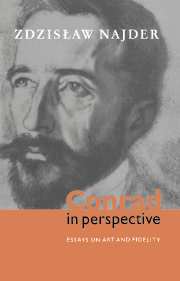Book contents
- Frontmatter
- Contents
- Acknowledgements
- Note on the texts
- List of abbreviations
- 1 Introduction, or confession of a mastodon
- 2 Conrad's Polish background, or from biography to a study of culture
- 3 Joseph Conrad's parents
- 4 Joseph Conrad and Tadeusz Bobrowski
- 5 The Sisters: a grandiose failure
- 6 Lord Jim: a Romantic tragedy of honour
- 7 The Mirror of the Sea
- 8 A Personal Record
- 9 Joseph Conrad's The Secret Agent, or the melodrama of reality
- 10 Conrad, Russia and Dostoevsky
- 11 Conrad and Rousseau: concepts of man and society
- 12 Conrad and the idea of honour
- 13 Joseph Conrad: a European writer
- 14 Joseph Conrad after a century
- 15 Joseph Conrad in his historical perspective
- 16 Fidelity and art: Joseph Conrad's cultural heritage and literary programme
- Notes
- Index
1 - Introduction, or confession of a mastodon
Published online by Cambridge University Press: 07 December 2009
- Frontmatter
- Contents
- Acknowledgements
- Note on the texts
- List of abbreviations
- 1 Introduction, or confession of a mastodon
- 2 Conrad's Polish background, or from biography to a study of culture
- 3 Joseph Conrad's parents
- 4 Joseph Conrad and Tadeusz Bobrowski
- 5 The Sisters: a grandiose failure
- 6 Lord Jim: a Romantic tragedy of honour
- 7 The Mirror of the Sea
- 8 A Personal Record
- 9 Joseph Conrad's The Secret Agent, or the melodrama of reality
- 10 Conrad, Russia and Dostoevsky
- 11 Conrad and Rousseau: concepts of man and society
- 12 Conrad and the idea of honour
- 13 Joseph Conrad: a European writer
- 14 Joseph Conrad after a century
- 15 Joseph Conrad in his historical perspective
- 16 Fidelity and art: Joseph Conrad's cultural heritage and literary programme
- Notes
- Index
Summary
Paraphrasing Conrad, I can say about myself that I have been neither ‘revolutionary’, nor even post-modernist in my critical efforts. I cannot claim methodological innocence: I lost it nearly half a century ago over Roman Ingarden's theory of the ‘literary work of art’, and have later exposed myself to structuralism and even to the more florid displays of deconstructivism. Still, my own approach to criticism and scholarship of literature has remained antediluvian.
I believe that poems and novels are there to be read by readers, not to be dissected by scholars. And the point of our reading a sonnet or a tale is that we want to feel, after we have finished, somewhat different than before we began. Perhaps emotionally, perhaps intellectually – whatever colours a given aesthetic experience has, whatever are the artistic components of the given piece of literature.
The critic's sole raison d'être is to assist the readers in their enjoyment and understanding. The scholar's primary raison d'être is to help the critic to assist the readers, or to communicate directly with the readers, with the same assisting purpose. The theorist's task is to make critics and scholars distinguish between talking sense (of different kinds) and spinning out gibberish. We all, critics, scholars, theoreticians, are middlemen (or better: midwives, performing a noble maieutic function) between the work and the reader; we are the reader's servants.
One trouble is that in the course of acquiring his knowledge and skills the scholar tends to become different from the ‘normal’ reader; and not only in what she or he knows but also in how he or she thinks about works of literature.
- Type
- Chapter
- Information
- Conrad in PerspectiveEssays on Art and Fidelity, pp. 1 - 10Publisher: Cambridge University PressPrint publication year: 1997



